|
|
|
Sort Order |
|
|
|
Items / Page
|
|
|
|
|
|
|
| Srl | Item |
| 1 |
ID:
170805
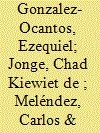

|
|
|
|
|
| Summary/Abstract |
How do parties target intimidation and vote-buying during elections? Parties prefer the use of carrots over sticks because they are in the business of getting voters to like them and expect higher legitimacy costs if observers expose intimidation. However, their brokers sometimes choose intimidation because it is cheaper and possibly more effective than vote-buying. Specifically, we contend that brokers use intimidation when the cost of buying votes is prohibitively high; in interactions with voters among whom the commitment problem inherent to clientelistic transactions is difficult to overcome; and in contexts where the risk of being denounced for violence is lower. We probe our hypotheses about the different profile of voters targeted with vote-buying and intimidation using two list experiments included in an original survey conducted during the 2011 Guatemalan general elections. The list experiments were designed to overcome the social desirability bias associated with direct questions about illegal or stigmatized behaviors. Our quantitative analysis is supplemented by interviews with politicians from various parties. The analysis largely confirms our expectations about the diametrically opposed logics of vote-buying and intimidation targeting, and illuminates how both are key components of politics in a country with weak parties and high levels of violence.
|
|
|
|
|
|
|
|
|
|
|
|
|
|
|
|
| 2 |
ID:
170802
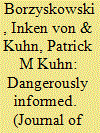

|
|
|
|
|
| Summary/Abstract |
A considerable literature examines the effect of voter information on candidate strategies and voter–politician interactions in the developing world. The voter information literature argues that information can improve accountability because more informed voters are harder to woo with traditional campaign tools, such as ethnic appeals and vote-buying. However, this literature has largely ignored the reaction of political candidates and thus may reach conclusions that are overly optimistic regarding the impact of information on electoral accountability. We argue that voter information can increase electoral violence in developing countries where politicians face fewer institutional constraints on their campaign tactics. When violence is used as a campaign strategy, more informed electorates are more at risk because they are harder to sway through alternative campaign techniques. Using data from 35 African countries, we show that respondents receiving their news predominantly from newspapers are a good proxy for informed voters because they differ in terms of their political attitudes from respondents consuming no news or receiving it via other channels. Combining the geo-coded survey data with pre-electoral violence event data, we find a robust positive association between newspaper readership and fear of and exposure to campaign violence. This finding contributes to the micro-foundations of election violence and adds a cautionary note for voter information programs.
|
|
|
|
|
|
|
|
|
|
|
|
|
|
|
|
| 3 |
ID:
170806
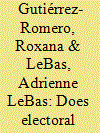

|
|
|
|
|
| Summary/Abstract |
Across many new democracies, voters routinely elect candidates associated with violence. Though electoral violence is common, there is little understanding of how it affects voting behaviour. This article examines how electoral violence affects turnout and vote choice. To this end, a vignette experiment is set in a nationally representative survey in Kenya, where electoral violence has been present since the 1990s. In the experiment, voters choose between two rival politicians. The experiment randomizes candidates’ attributes, their rumoured use of electoral violence and their record of reducing poverty. Conjoint analysis is used to isolate the effects of the candidates’ randomized attributes on turnout and vote choice. In contrast to the assumptions made in the literature on electoral violence, voters are less likely to vote for candidates rumoured to have used electoral violence, even when the candidate is a coethnic or a copartisan. This sanctioning effect, however, is not consistent across all voters. Victims of electoral violence and the poorest respondents are less likely to sanction candidates rumoured to have used violence, especially when these candidates have a good record of reducing poverty. The results show that voting turnout decreases when participants are asked to choose between candidates who are rumoured to have used electoral violence. These results are robust to including respondent and interviewer characteristics that might have affected participation in the experiment and how respondents voted. These findings explain why candidates using violence can win elections and why electoral violence has been difficult to eradicate in settings characterized by clientelism and instances of political discourse justifying the use of violence.
|
|
|
|
|
|
|
|
|
|
|
|
|
|
|
|
| 4 |
ID:
170809
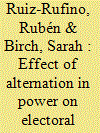

|
|
|
|
|
| Summary/Abstract |
There is as yet little consensus in the literature as to the underlying drivers of electoral violence. This article identifies a key mechanism explaining the use of electoral intimidation, a form of violence, in democratizing regimes. Within this context, we argue that the use of electoral intimidation against the opposition is most likely to be observed when a country moving to democracy has not yet experienced an electoral turnover. Building on previous theoretical and empirical findings, we provide evidence supporting the idea that alternation in power serves as an effective tool to decrease the tensions between electoral winners and losers. Furthermore, we show that alternation in power is conditional on the performance of electoral management bodies. Based on a sample of 331 elections in 53 countries that have inaugurated multiparty competition since 1989, we find strong and robust support for our theoretical claims. Firstly, we show how alternation in power is determined by the degree of autonomy the electoral management body adopted as part of the political opening process. Secondly, we provide evidence that electoral turnover depresses the use of electoral violence after controlling for relevant variables and correcting for selection issues.
|
|
|
|
|
|
|
|
|
|
|
|
|
|
|
|
| 5 |
ID:
170801


|
|
|
|
|
| Summary/Abstract |
Elections are held in nearly all countries in the contemporary world. Yet despite their aim of allowing for peaceful transfers of power, elections held outside of consolidated democracies are often accompanied by substantial violence. This special issue introduction article establishes electoral violence as a subtype of political violence with distinct analytical and empirical dynamics. We highlight how electoral violence is distinct from other types of organized violence, but also how it is qualitatively different from nonviolent electoral manipulation. The article then surveys what we have learned about the causes and consequences of electoral violence, identifies important research gaps in the literature, and proceeds to discuss the articles included in the special issue. The contributions advance research in four domains: the micro-level targeting and consequences of electoral violence, the institutional foundations of electoral violence, the conditions leading to high-stakes elections, and electoral violence in the context of other forms of organized violence. The individual articles are methodologically and geographically diverse, encompassing ethnography, survey vignette and list experiments and survey data, quantitative analyses of subnational and crossnational event data, and spanning Africa, Latin America, and Asia.
|
|
|
|
|
|
|
|
|
|
|
|
|
|
|
|
| 6 |
ID:
170808
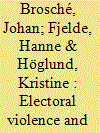

|
|
|
|
|
| Summary/Abstract |
Why do the first multiparty elections after authoritarian rule turn violent in some countries but not in others? This article places legacies from the authoritarian past at the core of an explanation of when democratic openings become associated with electoral violence in multi-ethnic states, and complement existing research focused on the immediate conditions surrounding the elections. We argue that authoritarian rule characterized by more exclusionary multi-ethnic coalitions creates legacies that amplify the risk of violent elections during the shift to multiparty politics. Through competitive and fragmented interethnic relations, exclusionary systems foreclose the forging of cross-ethnic elite coalitions and make hostile narratives a powerful tool for political mobilization. By contrast, regimes with a broad-based ethnic support base cultivate inclusive inter-elite bargaining, enable cross-ethnic coalitions, and reduce incentives for hostile ethnic mobilization, which lower the risk of violent elections. We explore this argument by comparing founding elections in Zambia (1991), which were largely peaceful, and Kenya (1992), with large-scale state-instigated electoral violence along ethnic lines. The analysis suggests that the type of authoritarian rule created political legacies that underpinned political competition and mobilization during the first multiparty elections, and made violence a more viable electoral strategy in Kenya than in Zambia.
|
|
|
|
|
|
|
|
|
|
|
|
|
|
|
|
| 7 |
ID:
170814


|
|
|
|
|
| Summary/Abstract |
False information, rumours and hate speech can incite violent protest and rioting during electoral periods. To counter such disinformation, United Nations peacekeeping operations (PKOs) routinely organize election-education events. While researchers tend to study how PKOs affect armed group and state behaviour, this study shifts the focus to civilians. It argues that PKOs’ election education reduces violent protest and rioting involving civilians during electoral periods via three pathways. First, learning about PKOs’ electoral security assistance during election-education events may convince people that political opponents cannot violently disturb elections, thereby mitigating fears of election violence. Second, election-education events provide politically relevant information that can strengthen political efficacy and people’s ability to make use of peaceful political channels. Finally, peace messages during election-education events can change people’s calculus about the utility and appropriateness of violent behaviour. Together, these activities mitigate fears, reduce political alienation and counter civilians’ willingness to get involved in violence. To test these expectations, I combine survey data on people’ perceptions and attitudes, events data on violent protest and rioting, and a novel dataset on local-level election-education events carried out by the PKO in Côte d’Ivoire before four elections held between 2010 and 2016. The results show that when the PKO is perceived to be an impartial arbiter, its election-education events have violence-mitigating effects at the individual and subnational levels.
|
|
|
|
|
|
|
|
|
|
|
|
|
|
|
|
| 8 |
ID:
170812
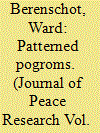

|
|
|
|
|
| Summary/Abstract |
The regular occurrence of election-related violence between ethnic or religious communities has generated a burgeoning literature on ‘the dark side’ of democracy. This literature provides convincing accounts of how political competition incentivizes politicians to foment violence. Yet such elite-oriented approaches are less convincing in explaining why and how political elites succeed in mobilizing people who do not share their concern for electoral benefits. This article addresses this challenge by relating the capacity of politicians to foment violence to the everyday functioning of patronage networks. Using ethnographic fieldwork to compare violent and nonviolent areas during Hindu–Muslim violence in Gujarat (2002) and Christian–Muslim violence in North Maluku (1999–2000), I find that the informal networks through which citizens gain access to state benefits (‘patronage networks’) shape patterns of election-related violence between religious communities. Politicians succeeded in fomenting violence in areas where citizens depended strongly on ethnicized patronage networks, while violence was averted in areas where state–citizen interaction was organized through networks that bridge religious divides. Interpreting this finding, I argue that patronage networks generate both infrastructure and incentives to organize violence. They provide the infrastructure for violence because their everyday functioning generates interdependencies between politicians and local followers that facilitate the instigation and organization of violence. Patronage networks also generate incentives for violence because when prevailing patronage networks bridge social divides, politicians relying on these networks have an interest in preventing communal violence. When socio-economic changes cause patronage networks to become organized along religious divides, as occurred in the violent areas in Gujarat and North Maluku, divisive political discourse is more likely to resonate and political actors are more likely to benefit electorally from communal violence. In this manner this article provides a novel explanation for both subnational variation in patterns of violence and the hardening of social divisions.
|
|
|
|
|
|
|
|
|
|
|
|
|
|
|
|
| 9 |
ID:
170810
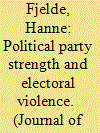

|
|
|
|
|
| Summary/Abstract |
Existing research on the causes of electoral violence has focused on structural determinants and election-specific characteristics but has paid less attention to the role of political agents that contest elections. This study addresses this gap by examining the relationship between the organizational strength of political parties and the risk of electoral violence. The study argues that strong political parties enhance the prospect for peaceful electoral dynamics for two reasons. First, having strong party organizations reduce incentives for violent electoral manipulation because these organizations enable more cost-efficient ways to mobilize voters. Second, strong party organizations constrain political actors from deploying electoral violence, both at the leadership and grassroot levels. The relationship between political party strength and electoral violence is studied by combining global data on the overall strength of political parties in the polity with data on violence across all national elections from 1946 to 2010. The statistical analysis accounts for a number of potentially confounding variables related to formal political institutions and election-specific characteristics. The results point to a statistically significant and substantively important association between strong political parties and a reduced risk of violent electoral conflict.
|
|
|
|
|
|
|
|
|
|
|
|
|
|
|
|
| 10 |
ID:
170807
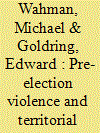

|
|
|
|
|
| Summary/Abstract |
Cross-national research on African electoral politics has argued that competition increases the prospects for pre-election violence. However, there is a dearth of systematic research on the effect of political competition on pre-election violence at the subnational level. We theorize that in African democracies characterized by competition at the national level but low subnational competitiveness (polarization), violence is often a manifestation of turf war and a tool to maintain and disrupt political territorial control. Consequently, contrary to expectations derived from the cross-national literature, pre-election violence is more likely in uncompetitive than competitive constituencies. Locally dominant as well as locally weak parties have incentives to perpetrate violence in uncompetitive constituencies. For locally dominant parties, violence is a tool to shrink the democratic space in their strongholds and maintain territorial control. For locally weak parties, violence can disturb the dominance of the opponent and protect their presence in hostile territory. We hypothesize that pre-election violence will be particularly common in opposition strongholds. In such locations, ruling parties can leverage their superior repressive resources to defend their ability to campaign, while the opposition can use their local capacity to reinforce the politics of territoriality. We test our hypotheses with original constituency-level election violence data from the 2016 Zambian elections. Data come from expert surveys of domestic election observers and represent a novel way of measuring low-level variations in election violence. Our analysis shows patterns of pre-election violence consistent with our theory on pre-election violence as a territorial tool.
|
|
|
|
|
|
|
|
|
|
|
|
|
|
|
|
| 11 |
ID:
170804
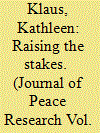

|
|
|
|
|
| Summary/Abstract |
How does large-scale land reform affect electoral stability and the prospects for election violence? While scholars have theorized elite-level logics of land distribution, few studies analyze the effects of land reform on the attitudes of ordinary citizens, and the implications such reforms have for electoral violence. The article uses an original survey and qualitative interviews in coastal Kenya to examine the effects of the Kenyan government’s recent land titling campaign, the most ambitious and extensive since independence. It theorizes and tests the micro-mechanisms through which the selective distribution of land rights in the pre-electoral period heightens or lowers the stakes of an electoral outcome by altering levels of political trust and perceived threat. Results indicate that title deed beneficiaries are more likely to trust political institutions than non-beneficiaries. Yet, while title deed recipients are more likely to trust state institutions, they are also more likely to fear the electoral process compared to non-beneficiaries. The findings reveal how the perceived stakes of an election can vary across local spaces. Where political trust is low and threat is high, citizens may view elections as particularly high-stakes events and, thus, may be more willing to take on the costs of participation in violence to ensure their preferred political outcome, or to defend themselves against anticipated attacks.
|
|
|
|
|
|
|
|
|
|
|
|
|
|
|
|
| 12 |
ID:
170813
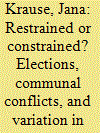

|
|
|
|
|
| Summary/Abstract |
Anecdotal evidence suggests that sexual violence varies significantly across cases of election violence and communal conflicts but systematic research is scarce. Post-election violence is particularly likely if electoral mobilization further polarizes longstanding communal conflicts and political elites do not instruct security forces to intervene decisively. I comparatively analyse two prominent cases of post-election violence in Kenya (2007/8) and Nigeria (2008) that exhibit stark variation in sexual violence. Patrimonial networks and norms of violent masculinity that increase the probability of (gang) rape were present in both cases and do not explain variation. Civil war research has identified three explanations for the variation in sexual violence: situational constraints; ordered sexual violence or restraint; and bottom-up dynamics of sexual violence or restraint. I examine these for the context of post-election violence. I argue that the type of communal conflict triggered by electoral mobilization explains variation in sexual violence. In Kenya, pogroms of a majority group against a minority allowed for the time and space to perpetrate widespread sexual violence while in Nigeria, dyadic clashes between similarly strong groups offered less opportunity but produced a significantly higher death toll. These findings have important implications for preventing election violence. They demonstrate that civilian vulnerability is gendered and that high levels of sexual violence do not necessarily correspond to high levels of lethal violence. Ignoring sexual violence means underestimating the real intensity of conflict and its impact on the political process.
|
|
|
|
|
|
|
|
|
|
|
|
|
|
|
|
| 13 |
ID:
170811
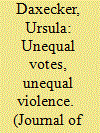

|
|
|
|
|
| Summary/Abstract |
Elections held outside of advanced, industrialized democracies can turn violent because elites use coercion to demobilize political opponents. The literature has established that closely contested elections are associated with more violence. I depart from this emphasis on competitiveness by highlighting how institutional biases in electoral systems, in particular uneven apportionment, affect incentives for violence. Malapportionment refers to a discrepancy between the share of legislative seats and the share of population, violating the ‘one person, one vote’ principle. Drawing on recent work on malapportionment establishing that overrepresented districts are targeted with clientelist strategies, are more homogenous, and are biased in favor of district-level incumbent parties, I argue that overrepresented districts present fewer incentives for using violence. In contrast, elites in well-apportioned or underrepresented districts exert less control over electoral outcomes because such districts have more heterogenous voter preferences, raising incumbent and opposition demands to employ violence. I examine the effects of malapportionment on violence using constituency-level elections data and new, disaggregated, and geocoded event data on the incidence of election violence in India. Results from six parliamentary elections from 1991 to 2009 show that electoral violence is less prevalent in overrepresented constituencies, and that violence increases in equally apportioned and moderately underrepresented districts. The analysis establishes additional observable implications of the argument for district voter homogeneity and incumbent victory, accounts for confounders such as urbanization and state-level partisanship, and validates measures of election violence. The findings illustrate that institutional biases shape incentives for electoral violence.
|
|
|
|
|
|
|
|
|
|
|
|
|
|
|
|
|
|
|
|
|